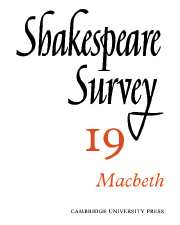Book contents
- Frontmatter
- ‘Macbeth’ in the Twentieth Century
- The Criminal as Tragic Hero: Dramatic Methods
- Antithesis in ‘Macbeth’
- Why was Duncan’s Blood Golden?
- Image and Symbol in ‘Macbeth’
- ‘Macbeth’ and The Furies
- Hell-Castle and its Door-Keeper
- ‘His Fiend-Like Queen’
- The Fiend-Like Queen: A Note on ‘Macbeth’ and Seneca’s ‘Medea
- Shakespeare at Street Level
- New Findings with Regard to the 1624 Protection List
- Shakespeare Productions in the United Kingdom: 1965
- The Royal Shakespeare Company 1965
- The Year's Contributions to Shakespearian Study: 1 Critical Studies
- 2 Shakespeare’s Life, Times and Stage
- 3 Textual Studies
- Index
- Plate Section
The Criminal as Tragic Hero: Dramatic Methods
Published online by Cambridge University Press: 28 March 2007
- Frontmatter
- ‘Macbeth’ in the Twentieth Century
- The Criminal as Tragic Hero: Dramatic Methods
- Antithesis in ‘Macbeth’
- Why was Duncan’s Blood Golden?
- Image and Symbol in ‘Macbeth’
- ‘Macbeth’ and The Furies
- Hell-Castle and its Door-Keeper
- ‘His Fiend-Like Queen’
- The Fiend-Like Queen: A Note on ‘Macbeth’ and Seneca’s ‘Medea
- Shakespeare at Street Level
- New Findings with Regard to the 1624 Protection List
- Shakespeare Productions in the United Kingdom: 1965
- The Royal Shakespeare Company 1965
- The Year's Contributions to Shakespearian Study: 1 Critical Studies
- 2 Shakespeare’s Life, Times and Stage
- 3 Textual Studies
- Index
- Plate Section
Summary
The difficulties presented by the character of Macbeth—the criminal as tragic hero—have led some critics to charge Shakespeare with inconsistency, others to seek consistency by viewing the initial Macbeth as in some way morally defective, and still others to normalize the hero by viewing the final Macbeth as in some way morally triumphant. Perhaps a recollection of Lascelles Abercrombie’s enthusiastic phrase, ‘the zest and terrible splendour of his own unquenchable mind’ (1925), and of Wilson Knight’s comparable ‘emerges at last victorious and fearless’ (1930), helped stir L. C. Knights to complain (1933) that ‘the critics have not only sentimentalized Macbeth—ignoring the completeness with which Shakespeare shows his final identification with evil—but they have slurred the passages in which the positive good is presented by means of religious symbols’. Even after this, so unflighty an editor as Kittredge could say that Macbeth ‘is never greater than in the desperate valour that marks his end’. On the other hand, the editor of a Macbeth meant for schools describes Macbeth as a ‘bold, exacting and presumptuous criminal, . . . bent on destruction for destruction’s sake’, ‘the champion of evil’, ‘a monster’, giving ‘the impression . . . of some huge beast who . . . dies lashing out at everyone within range’.
- Type
- Chapter
- Information
- Shakespeare Survey , pp. 12 - 24Publisher: Cambridge University PressPrint publication year: 1967



